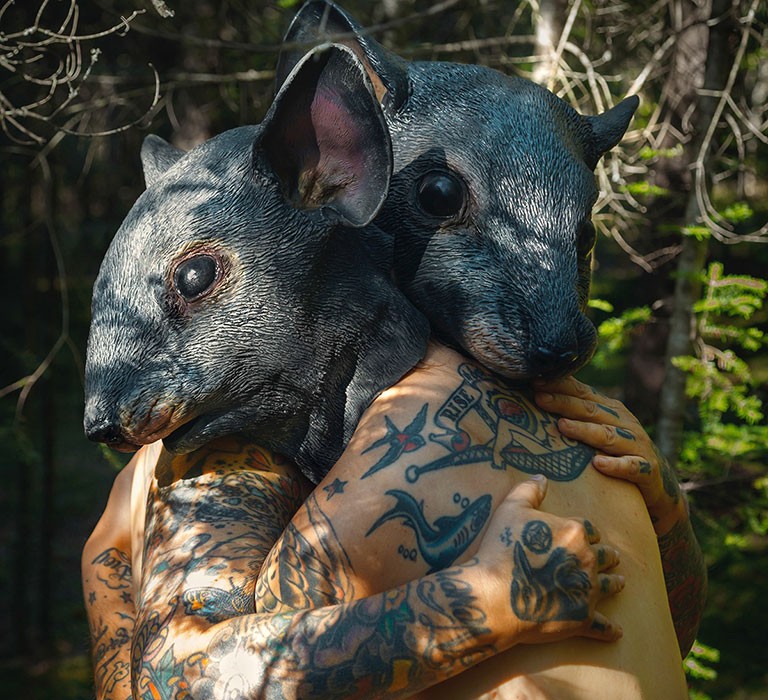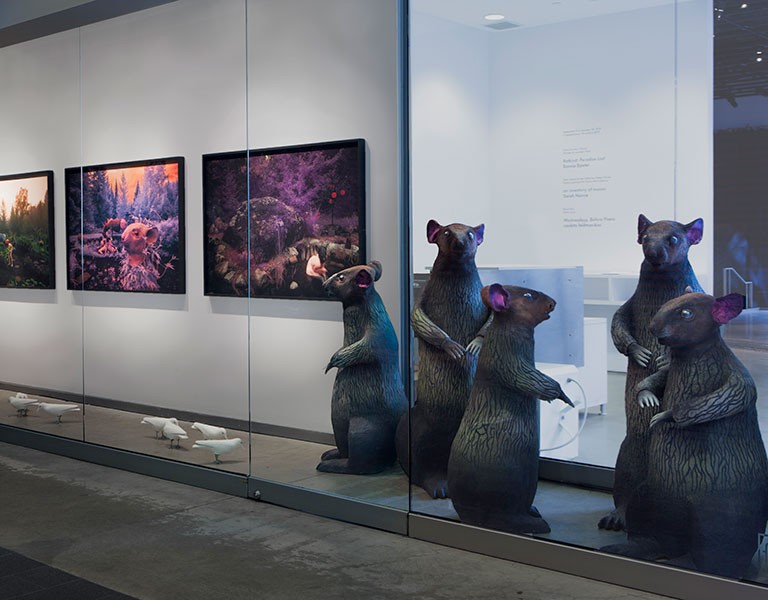“Can we see beyond the face of a thing to the heart of a being?”
Bonnie Baxter, Exhibition Statement, 2019
When Bonnie Baxter was a child, the world was a promise, like a mother’s kiss on the forehead: everything would be alright. Still reeling from the losses of two world wars, it was a world moving from black and white to colour and just about everyone was in a hurry to get on with working, playing, and consuming. Fast forward some 65 years and you have the artist Bonnie Baxter and the kernel of what is motivating RatKind, a series of installations that invite the viewer to enter an implausible utopian/dystopian future in which hominoid rodents have supplanted humans.
RatKind: Paradise Lost is the most recent exhibition of Bonnie Baxter’s surreal, challenging, and somewhat disturbing, multi-media RatKind series. More than an exhibition, it is a statement of involvement and a commitment to the future. Concurrent with the exhibition, Baxter has joined with FASA to support Student Art Actions for the Planet as they repurpose Baxter’s memorial banner Coming Out of Sleep (a former commission from Concordia University) to create a collective mural for the FOFA Courtyard. She has also invited Melbourne based Canadian artist/researcher Dr. Jen Rae, to talk to students and community members on September 13th about the role of the artist in the event of ecological crises. The message is clear, there is no more time to waste, together we must adapt to the reality we have created or lose the paradise we live in.
The installation combines digital prints, luminous videos created using drone and infra-red technologies, surreal ceramic and papier mâché sculptures of rats approximately the size of adult humans and ghostly white ceramic crows with pewter talons.
In 2017 Jonathan Demers, curator of the MAC LAU (Musée d'art contemporain des Laurentides) in Saint-Jérôme, approached Baxter about creating a flagship exhibition—part retrospective and part something entirely new—for their 30th anniversary. Baxter proposed RatKind as a response to Trump’s America and the generally retrograde state of world politics and human rights. Over a period of months in 2018 most of RatKind’s elements were created in the astonishing natural setting and spectacular gardens of the artist’s mountain home in Val-David. A small army of students, artists and members of various communities, partnered to become models, performers and participants in extensive video and photography sessions. Their motivational premise: a future in which RatKind had emerged from the shadows of human-made ecological disaster, to build a utopia based on empathy for all living things and respect for all forms of sentience - kindness over kind.

 Artist, Bonnie Baxter, EMBRACE (RatKind Series) Digital Image, 40 h x 27 w inches, 2018
Artist, Bonnie Baxter, EMBRACE (RatKind Series) Digital Image, 40 h x 27 w inches, 2018
 2-Installation View, Bonnie Baxter Artist, RatKind: Paradise Lost, FOFA Gallery, Vitrines, 2019 (photo credit: CB)
2-Installation View, Bonnie Baxter Artist, RatKind: Paradise Lost, FOFA Gallery, Vitrines, 2019 (photo credit: CB)